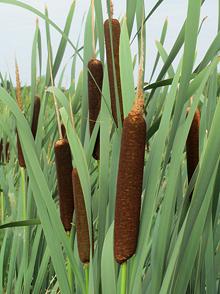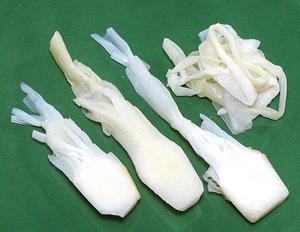 [Typha latifolia (Common Cattail, Broadleaf Cattail) |
Typha angustifolia (Narrowleaf Cattail) |
other species of genus Typha in family Typhaceae]
[Typha latifolia (Common Cattail, Broadleaf Cattail) |
Typha angustifolia (Narrowleaf Cattail) |
other species of genus Typha in family Typhaceae]
Cattails are a dominant feature of many wetland environments worldwide, and can be very difficult to control invasives. T. latifolia, the most widespread species, is considered a troublesome invasive in Hawaii and Australia. T. orientalis is native to all of Australia and New Zealand.
Cattail flowers are two part: a male spike at the top, and a sausage shaped female flowerhead below it. The female flowerhead matures, then bursts into many thousands of wind-born seeds. The two most widespread species can easily be told apart if flowering. T. angustifolia has a space between the male and female spikes, while T. latifolia has no space. Photo of T. latifolia by AnRo0002 distributed under license Creative Commons CC0 1.0 Universal Public Domain Dedication.
All parts of cattail plants are edible during one or more stages of maturity.
More on Poales.
 [Bon bon (Viet); "Cossack Asparagus"]
[Bon bon (Viet); "Cossack Asparagus"]
Stems and leaf bases are edible, prepared in various ways. The Russian
Cossacks have long eaten them raw or boiled. While called "Cossack
Asparagus", the flavor has been reported more like cucumber. The
photo specimens, "Bon Bon Chua Ngot" (probably T. angustifolia),
were pickled, a product of Vietnam. They were mild and lightly crunchy.
Ingred: cattail, water, sugar, salt, vinegar, chili, preservative (E202
(potassium sorbate)).